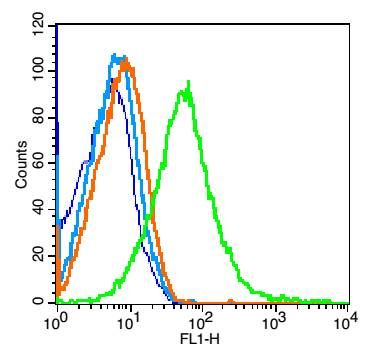KIRREL3 Polyclonal Antibody
Purified Rabbit Polyclonal Antibody (Pab)
- SPECIFICATION
- CITATIONS
- PROTOCOLS
- BACKGROUND

Application
| IHC-P, IHC-F, IF, ICC, E |
|---|---|
| Primary Accession | Q8IZU9 |
| Reactivity | Rat |
| Host | Rabbit |
| Clonality | Polyclonal |
| Calculated MW | 83 KDa |
| Physical State | Liquid |
| Immunogen | KLH conjugated synthetic peptide derived from human KIRREL3 |
| Epitope Specificity | 351-450/778 |
| Isotype | IgG |
| Purity | affinity purified by Protein A |
| Buffer | 0.01M TBS (pH7.4) with 1% BSA, 0.02% Proclin300 and 50% Glycerol. |
| SUBCELLULAR LOCATION | Cell membrane; Single-pass type I membrane protein |
| SIMILARITY | Belongs to the immunoglobulin superfamily. Contains 5 Ig-like C2-type (immunoglobulin-like) domains. |
| SUBUNIT | Interacts with the C-terminus of NPHS2/podocin. Interacts with CASK. |
| Post-translational modifications | Phosphorylation probably regulates the interaction with NSH2. Phosphorylated at Tyr-605 and Tyr-606 by FYN, leading to GRB2 binding (By similarity).N-glycosylated (By similarity). |
| DISEASE | Note=A chromosomal aberration involving KIRREL3 and CDH15 is found in a patient with severe mental retardation and dysmorphic facial features. Translocation t(11;16)(q24.2;q24). Defects in KIRREL3 are the cause of mental retardation autosomal dominant type 4 (MRD4) [MIM:612581]. Mental retardation is characterized by significantly sub-average general intellectual functioning associated with impairments in adaptative behavior and manifested during the developmental period. |
| Important Note | This product as supplied is intended for research use only, not for use in human, therapeutic or diagnostic applications. |
| Background Descriptions | NEPH2 is a 778 amino acid single-pass type I membrane protein that belongs to the nephrin-like protein family and immunoglobulin superfamily. Expressed in both fetal and adult brain, as well as podocytes of kidney glomeruli, NEPH2 contains five Ig-like C2-type (immunoglobulin-like) domains and is thought to plaly a role in the hematopoetic supportive capacity of stroma cells. NEPH2 undergoes alternative splicing to produce two isoforms and contains a C-terminal cytoplasmic domain which it uses to interact with Podocin, a podocyte protein involved in ultrafiltration. Defects in the gene encoding NEPH2 are associated with mental retardation autosomal dominant type 4 (MRD4). |
| Gene ID | 84623 |
|---|---|
| Other Names | Kin of IRRE-like protein 3, Kin of irregular chiasm-like protein 3, Nephrin-like protein 2, Processed kin of IRRE-like protein 3, KIRREL3 (HGNC:23204) |
| Target/Specificity | Expressed in fetal and adult brain. Also expressed in kidney, specifically in podocytes of kidney glomeruli. |
| Dilution | IHC-P=1:100-500,IHC-F=1:100-500,ICC=1:100-500,IF=1:100-500,Flow-Cyt=1 µg/Test,ELISA=1:5000-10000 |
| Storage | Store at -20 ℃ for one year. Avoid repeated freeze/thaw cycles. When reconstituted in sterile pH 7.4 0.01M PBS or diluent of antibody the antibody is stable for at least two weeks at 2-4 ℃. |
| Name | KIRREL3 (HGNC:23204) |
|---|---|
| Function | Synaptic adhesion molecule required for the formation of target-specific synapses. Required for formation of target-specific synapses at hippocampal mossy fiber synapses. Required for formation of mossy fiber filopodia, the synaptic structures connecting dentate granule and GABA neurons. Probably acts as a homophilic adhesion molecule that promotes trans-cellular interactions and stabilize mossy fiber filipodia contact and subsequent synapse formation. Required for the coalescence of vomeronasal sensory neuron axons. May be involved in the hematopoietic supportive capacity of stroma cells; the secreted extracellular domain is directly responsible for supporting hematopoietic stem cells. |
| Cellular Location | Cell membrane; Single-pass type I membrane protein |
| Tissue Location | Expressed in fetal and adult brain (PubMed:19012874). Also expressed in kidney, specifically in podocytes of kidney glomeruli (PubMed:12424224). Also expressed in skeletal muscle (PubMed:25488023). |

Thousands of laboratories across the world have published research that depended on the performance of antibodies from Abcepta to advance their research. Check out links to articles that cite our products in major peer-reviewed journals, organized by research category.
info@abcepta.com, and receive a free "I Love Antibodies" mug.
Provided below are standard protocols that you may find useful for product applications.
If you have used an Abcepta product and would like to share how it has performed, please click on the "Submit Review" button and provide the requested information. Our staff will examine and post your review and contact you if needed.
If you have any additional inquiries please email technical services at tech@abcepta.com.













 Foundational characteristics of cancer include proliferation, angiogenesis, migration, evasion of apoptosis, and cellular immortality. Find key markers for these cellular processes and antibodies to detect them.
Foundational characteristics of cancer include proliferation, angiogenesis, migration, evasion of apoptosis, and cellular immortality. Find key markers for these cellular processes and antibodies to detect them. The SUMOplot™ Analysis Program predicts and scores sumoylation sites in your protein. SUMOylation is a post-translational modification involved in various cellular processes, such as nuclear-cytosolic transport, transcriptional regulation, apoptosis, protein stability, response to stress, and progression through the cell cycle.
The SUMOplot™ Analysis Program predicts and scores sumoylation sites in your protein. SUMOylation is a post-translational modification involved in various cellular processes, such as nuclear-cytosolic transport, transcriptional regulation, apoptosis, protein stability, response to stress, and progression through the cell cycle. The Autophagy Receptor Motif Plotter predicts and scores autophagy receptor binding sites in your protein. Identifying proteins connected to this pathway is critical to understanding the role of autophagy in physiological as well as pathological processes such as development, differentiation, neurodegenerative diseases, stress, infection, and cancer.
The Autophagy Receptor Motif Plotter predicts and scores autophagy receptor binding sites in your protein. Identifying proteins connected to this pathway is critical to understanding the role of autophagy in physiological as well as pathological processes such as development, differentiation, neurodegenerative diseases, stress, infection, and cancer.


